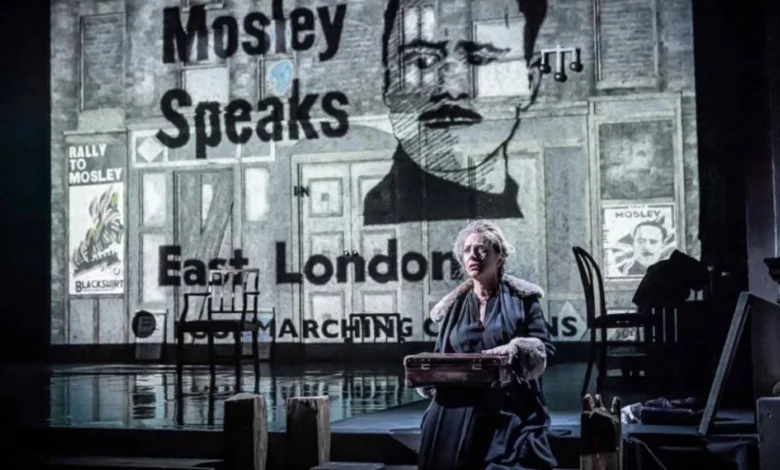
Review: The Merchant of Venice 1936 At The Playhouse Theatre
A single candle flickers, a fragile point of light against the encroaching darkness. Hebrew prayers, ancient and resonant, murmur through the air, a whisper of tradition in a world about to be torn apart. Then, the illusion shatters. This is not the gilded cage of Shakespeare’s Venice, but the grimy reality of London’s East End, 1936.
This production of The Merchant of Venice, a bold and unsettling reimagining, is a theatrical time machine, transporting us to a world on the precipice, where the familiar story of Shylock’s bond is refracted through the chilling lens of rising Fascism. The insidious creep of Oswald Mosley’s blackshirts, their message of hate a toxic fog, hangs heavy in the air, a palpable threat to the fragile peace of this community. This is not mere revival; it is resurrection, an exhumation of a buried past, a stark and urgent reminder of the ever-present danger of bigotry.
Tracy-Ann Oberman’s Shylock is a revelation, a performance that redefines the character for our times. The stereotypical caricature, the hook-nosed villain, is gone, replaced by a woman of formidable strength, a widowed mother, a survivor of pogroms. Oberman’s Shylock is not simply a victim; she is a fighter, her humanity scarred but not broken by unimaginable hardship. She is a businesswoman in a prejudiced world, her resilience born of necessity.
Oberman imbues her with a palpable vulnerability, a deep-seated fear that flickers beneath her strength, and a fierce, unwavering love for her daughter. This Shylock is forged in the crucible of persecution, a woman whose experiences have taught her the true cost of survival. This production does not just dust off a classic; it exhumes a past many would prefer to forget, a timely and urgent reminder of the ever-present danger of bigotry, particularly resonant in our own era of resurgent antisemitism and other forms of hate.
The staging of The Merchant of Venice 1936 is a masterclass in understated power. The set, meticulously designed, provides just enough to draw us into Shylock’s world, a space that feels both lived-in and precarious, a refuge constantly threatened by the encroaching agents of intolerance. Seamless scene changes create a sense of continuous narrative flow, immersing us in the drama unfolding before us.
The back of the stage serves a dual purpose: part of the set, and a canvas for striking contemporary images and archival footage. These projections, carefully curated, add layers of historical context, reminding us that these personal struggles are linked to broader social and political forces. They are a constant, unsettling reminder of the real-world consequences of prejudice. The sound and lighting design are impeccably synchronised, subtly enhancing the atmosphere, creating an almost cinematic experience, amplifying the unease that permeates the narrative.
Liz Cooke’s costumes instantly evoke 1936 London, where tension simmers between the Jewish community and Mosley’s British Union of Fascists. The red armbands of the BUF are a chilling echo of their Nazi counterparts, a stark visual reminder of the ideological poison spreading across Europe. These costumes are not just period-appropriate; they are imbued with symbolic meaning, a visual shorthand for the forces of hate. Greta Zabulyte’s video designs amplify this unease, projecting alarming antisemitic headlines and menacing crowds. These projections are not mere background; they are a constant presence, a reminder that the dramas onstage unfold against a backdrop of persecution and violence. They serve as a visual chorus, underscoring the play’s themes.
The ensemble cast is uniformly excellent. The delivery and pacing are impeccable, Shakespeare’s language resonating with a contemporary audience. Each actor embodies their character with conviction, creating a rich tapestry of human interaction. The supporting characters, often overlooked, are given their due, contributing to the sense of a vibrant community under siege. This ensemble work is crucial, creating an authenticity that elevates the play beyond mere historical reenactment.
This meticulous framework culminates in a powerful finale, a glimpse of solidarity inspired by the Battle of Cable Street. Oberman’s Shylock breaks the fourth wall, praising the unity shown by diverse groups – Black, Irish, socialist, Trade Unionist – who came to the aid of the Jewish community against Fascist aggression. It is a moment of catharsis, a testament to the power of collective action. However, this finale, while powerful, raises questions about the narrative arc that this production has introduced.
The sudden shift from Shylock’s downfall to a celebratory depiction of East End unity jars and just doesn’t sit well, unfortunately. The sense of camaraderie among Shylock’s neighbors is not sufficiently established earlier, making the ending feel tacked on.While the historical context is relevant, its inclusion feels forced, and the grafting of a narrative onto Shakespeare’s structure will always have this effect. The connection between Shylock’s tragedy and the political struggle is not always clear, leaving a sense of thematic dissonance. Similarly, Portia’s subplots now seem incongruous and not needed in this gritty production. These inconsistencies, while perhaps minor, diminish this productions overall impact.
The Merchant of Venice 1936 opened in February 2023, and since then, its sentiment generated by the closing scene has been overtaken by world events. The resurgence of antisemitism makes this production even more timely, but also underscores the tragic reality that its themes are not simply historical artifacts. This is the inherent risk of incorporating specific historical events into Shakespeare. Sometimes, you are caught out by the march of time. But this should never deter artists from taking risks.
While this production may not be perfect, it is thought-provoking, raising important questions about prejudice, identity, and the enduring relevance of Shakespeare. It deserves to be seen, discussed, and debated. This Merchant of Venice 1936 is not just a contemporary production of one of Shakespeare’s most famous works: it is a conversation, a dialogue with history, and a challenge to our consciences.
And well worth seeing.
See what shows are coming up at the Liverpool Everyman and Playhouse theatres.
Steve Kinrade – @kinras66
Photo Credit: Marc Brenner







